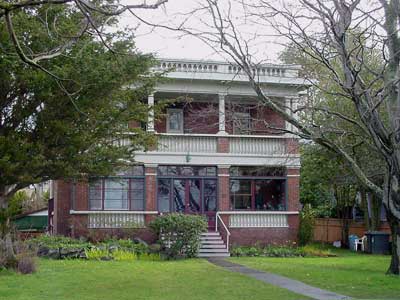Heritage Register
James Bay
138 Dallas Rd
Newcombe House
Built
1907-08
Heritage-Designated 1977
For: Charles F. Newcombe
Architect: William Ridgway Wilson

ARCHITECTURE:
Newcombe House, a Classical Revival-style, two-storey, flat-roofed brick house, cost $6,000 to build. A parapet, balustraded along the front façade, continues with a solid parapet along the left and right sides of the house. The wide eaves below are supported on paired modillions, tripled at all the corners, over a broad frieze. The front has an almost-full-width two-storey verandah, known as a double loggia; the lower level has square brick posts, the upper has Tuscan columns on short brick piers. The windows enclosing the lower verandah are a later addition. There are a pair of two-storey angled bays on the right side, and one on the left front within the loggia. On the left side is a tall, round-arched stairway window; it interrupts the broad beltcourse which surrounds the house between the first and second floors. There is a basement, and the foundation is concrete. There is a new addition on the rear.
The double loggia, columns, modillioned eaves, and three levels of balustrade are all features of the Classical Revival. The style can be seen in many country houses, influenced by the Italian Renaissance, which were built during the 18th and 19th centuries in the British Isles and many former British colonies, notably the southern USA.
ORIGINAL OCCUPANTS:
Charles Frederick Newcombe was born in Newcastle-upon-Tyne, England, in 1851. He earned an MB and MD from the University of Aberdeen in Scotland. In 1879 he married Marion, who was born in India in 1858 but moved to England at an early age. In 1882 they and their three children sailed to San Francisco. In 1884 in Hood River, OR, Charles began anthropological and biological studies of local flora and fauna, in addition to practising medicine. The Newcombes arrived in Victoria in 1889. Charles joined the local natural history society and met Provincial Museum curator John Fannin. Financial investments allowed Charles to indulge his interests in botany, anthropology, geology and photography. His detailed photographic accounts of coastal aboriginal culture remain an important component of the Royal BC Museum.
Marion died after giving birth to their sixth child in 1891; the baby died six months later. Charles returned to England for a year to renew and establish scientific connections. On his return to Victoria, he began collecting coastal aboriginal artifacts including fossils, totem poles, and other items. He did contract collection work for curators and private collectors outside the country, an acceptable practice at that time. In 1906, Charles began selling his collection, most of it to the Canadian Geological Survey in Ottawa for $6500, which paid for the construction of this house.
Charles was also a noted marine zoologist; his extensive studies of sea lions contributed greatly to the Provincial fisheries department. His publications include The First Circumnavigation of Vancouver Island in 1914, recounting Captain George Vancouver’s explorations of the region, and edited journals pertaining to the botanical and ethnological aspects of Vancouver’s voyages. In 1924, Charles died of pneumonia after one of his voyages north.
The oldest boys, William and Charles, often accompanied their father on his voyages. Charles became a surveyor and lived in this house until he died in 1959 at 75. William followed his father in anthropology and biology. Although self-taught he gained a reputation for his extensive knowledge of coastal aboriginal groups that rivaled even his father’s. William was curator of the Provincial Museum from 1928-32, but was abruptly dismissed for supposedly stealing artifacts, which were later found stored in the museum. He lived a relatively secluded life after that.
William and Emily Carr (642-646 Simcoe St, James Bay) were good friends. While his father did not appreciate Emily’s art, going so far as to advise the Provincial Museum to refuse her paintings, William faithfully stood by her, and helped her out to the best of his abilities. Emily acknowledged this by making him an executor of her estate. William died in 1960 at 75 years of age. Executors found in his house an inventory of BC aboriginal arts and crafts, as well as valuable books, private papers, photographs, and almost 100 Emily Carr paintings.

